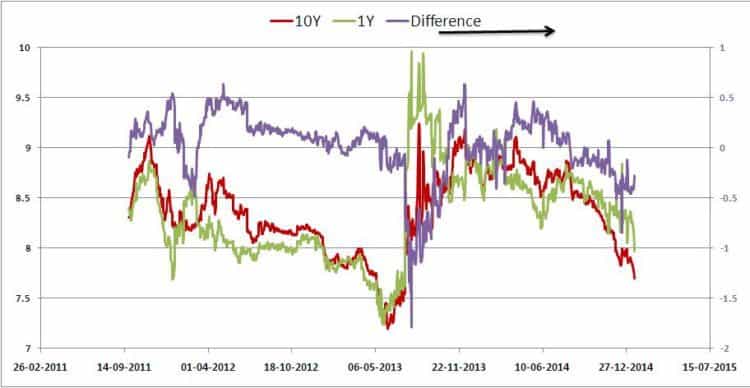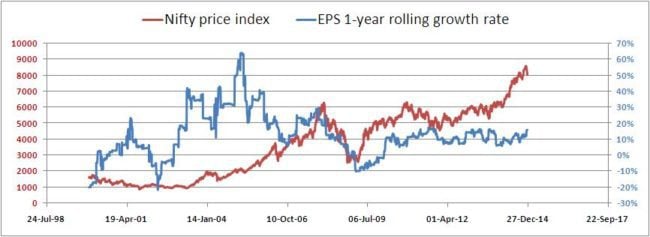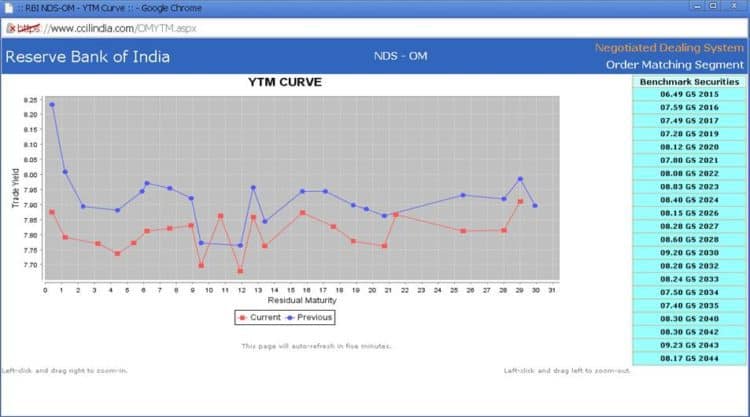Last Updated on October 1, 2023 at 5:38 pm
RBI surprised everyone by announcing a 0.25% reduction in repo rate (from 8%) yesterday. The market welcomed this news with a sharp rise. Several self-proclaimed long-term investors welcomed their prospective notional gains as enthusiastically as they despaired at their notional losses when the markets ‘crashed’ a few days ago
Here is a perspective of ‘where we stand’ by a student of the bond market.
Let us start with the definition of bond yield. We will limit ourselves with the simplest definition that the yield represents the IRR of the bond investment, taking into account all the interest payments along with the investment and receipt of the investment upon maturity. Things become complicated if the bond is purchased mid-way but the notion that the yield represents IRR is always true.
When rates fall, new bonds have lower coupon rates (interest rates), resulting in lower IRR and lower yields. To ensure existing bonds can be sold, their yields must be matched (lowered in this case) to the new bonds. This is done by increasing the price of existing bonds. Thus, higher the price of an existing bond, lower its yield.
Join 32,000+ readers and get free money management solutions delivered to your inbox! Subscribe to get posts via email! (Link takes you to our email sign-up form)
🔥Want to create a complete financial plan? Learn goal-based investing? Exclusive access to our DIY tools? Increase your income with your skills? Enjoy massive discounts on our robo-advisory tool & courses! 🔥
The difference between the long-term and short-term bond yields can be thought of as an indicator of the state of the economy and therefore of the equity markets. This idea can be graphically represented by the so-called yield curve, where the current yields of short and long-term bonds are plotted. I will soon write a detailed post on the yield curve along with a yield curve generator. For now, I will focus on the difference between the 10Y bond yield and the 1Y bond yield.
When the economy is flourishing or if the outlook for the future is positive, money is borrowed for the long-term. Demand of long-term bonds is high enough, supply is high enough and therefore the price is low (enough!) and hence during such times, long-term bond yields are higher than short-term yields by about 1-2% or even more.
When no one borrows money for the long-term fearing a bearish market, the difference between the long-term and short-term yield diminishes (the yield curve is flat).
This phase, where the yields are typically the same irrespective of duration indicates economic slowdown. I don’t have access to bond data beyond Sep. 2011, but I am willing to wager that ever since the 2008 crash, or thereabouts we have been plagued with economic slowdown resulting in a flat yield curve. This can also be seen by the sideways movement in the Nifty EPS growth rate.
Use the Nifty valuation analyzer for more such insights.
Let us now look at the 10Y and 1Y bond yields and the difference between them from Sep. 2011. Both the right and left axis represent percentages.

I am unable to find out the origin behind the sharp dip in late 2011. Notice the difference plotted in purple (right axis). The difference is barely positive and does not move much before the July 2013 crash.
In the months leading up to the crash the yields nose-dived. Which I think is because of heightened activity mainly in short-term bonds triggered by the depreciating rupee. Do correct me if I am wrong.
In July 2013, RBI hiked the short-term interest rate to stem the purchase of short-term bonds, reduce liquidity in the market and support the falling rupee. The above graph indicates this move with a sharp increase in 1Y yield.
When the short-term rates increased, the FIIs suffered notional losses and made them real by exiting in panic. Banks redeemed from liquid funds to bolster liquidity pulling down their NAVs
Suddenly the 1Y yield was higher than the 10Y yield. RBI had ‘inverted’ the yield curve. Typically, short-term yields higher than long-term yields would imply a recession, but this was an artificial inversion created to save the rupee.
In the next few months, the difference between the yields got erased and as elections loomed, the equity markets picked up in the hope of a ‘strong’ government. Soon after the BJP government took over, inflation stabilized and began to drop.
There was an indication that rates will not be increased anymore and then there was the hope that it would be cut. With this hope, investors (of whom the FIIs are significant) started to buy both long-term bonds (to gain from the rate cut) and short-term bonds (to lock-in to the high rates. As a result, the yields plunged downward.
Yesterday, both the yields went down sharply in reaction to the rate cut.
As mentioned above, this is because, when rates fall, new bonds will be issued with lower coupon rates (interest rates), that is with lower yields. The existing bonds yields will be lowered to match the yield of the new bonds. To do this, existing bond prices increase.
As of yesterday, the 1Y bond yield (tracked at investing.com) is still higher than the 10Y yield. This means that we not out of the woods. That is, this rate is not a sign that the economy has picked up.
The online yield curve maintained at Clearing Corporation of India is shown below for yesterday (red) and the day before (14th; blue) is shown below. Thanks to Rajendra Dixit for pointing me towards this resource.
Notice the sharp lowering of the short-term yields in reaction to the rate cut. Other short-term bonds, not part of this curve plunged even lower (automated yield curve generator is coming soon). This is only to illustrate the effect of a rate cut. This represents data for two days. Dont read too much into it.
It is important to recognise that this rate cut (hopefully the first in a series of such cuts) means little because of the following reasons:
- Inflation in India depends on international oil prices and monsoons among other things. These are beyond our control.
- Stability of the rupee is important. This is a complex problem. Some factors depend on how easy it is for the government to pass laws. Some factors originate outside the country. The rupee has been ‘stable’ for just over an year now. So let us not get too comfortable.
- Both the above factors, if favourable, will sooner or later reflect in the rate at which earnings per share increases (hopefully!). When that happens, I can afford a smile and pray for the bull run to continue.
- Sooner or later, the 1Y yield will first drop lower than the 10Y yield and the drop even lower. At which time repo rate will be increased soon and yet another cycle of jubilation and despair would begin.
- This rate cut is certainly a step in the right direction. Although a journey starts with a step, it is only a step. There is nothing special about it.
It will take more cuts to ensure the long-term yield edges higher than the short-term yield. Hopefully, those cuts will come down the line gradually. Any sharp rate cut comes with the danger of a retraction, which will seriously hurt investor sentiment.
Why bother? Why can’t we ignore this noise and focus on our financial requirements and then move onto other things? Why must we jump up or down in reaction to a non-event which is part of a cycle anyway? Beats me.
If you can provide additional insights or would like to correct any of the above interpretations, please do so.
🔥Enjoy massive discounts on our courses, robo-advisory tool and exclusive investor circle! 🔥& join our community of 7000+ users!
Use our Robo-advisory Tool for a start-to-finish financial plan! ⇐ More than 2,500 investors and advisors use this!
Track your mutual funds and stock investments with this Google Sheet!
We also publish monthly equity mutual funds, debt and hybrid mutual funds, index funds and ETF screeners and momentum, low-volatility stock screeners.





- Do you have a comment about the above article? Reach out to us on Twitter: @freefincal or @pattufreefincal
- Have a question? Subscribe to our newsletter using the form below.
- Hit 'reply' to any email from us! We do not offer personalized investment advice. We can write a detailed article without mentioning your name if you have a generic question.
Join 32,000+ readers and get free money management solutions delivered to your inbox! Subscribe to get posts via email! (Link takes you to our email sign-up form)
About The Author
 Dr M. Pattabiraman(PhD) is the founder, managing editor and primary author of freefincal. He is an associate professor at the Indian Institute of Technology, Madras. He has over ten years of experience publishing news analysis, research and financial product development. Connect with him via Twitter(X), Linkedin, or YouTube. Pattabiraman has co-authored three print books: (1) You can be rich too with goal-based investing (CNBC TV18) for DIY investors. (2) Gamechanger for young earners. (3) Chinchu Gets a Superpower! for kids. He has also written seven other free e-books on various money management topics. He is a patron and co-founder of “Fee-only India,” an organisation promoting unbiased, commission-free investment advice.
Dr M. Pattabiraman(PhD) is the founder, managing editor and primary author of freefincal. He is an associate professor at the Indian Institute of Technology, Madras. He has over ten years of experience publishing news analysis, research and financial product development. Connect with him via Twitter(X), Linkedin, or YouTube. Pattabiraman has co-authored three print books: (1) You can be rich too with goal-based investing (CNBC TV18) for DIY investors. (2) Gamechanger for young earners. (3) Chinchu Gets a Superpower! for kids. He has also written seven other free e-books on various money management topics. He is a patron and co-founder of “Fee-only India,” an organisation promoting unbiased, commission-free investment advice.Our flagship course! Learn to manage your portfolio like a pro to achieve your goals regardless of market conditions! ⇐ More than 3,000 investors and advisors are part of our exclusive community! Get clarity on how to plan for your goals and achieve the necessary corpus no matter the market condition is!! Watch the first lecture for free! One-time payment! No recurring fees! Life-long access to videos! Reduce fear, uncertainty and doubt while investing! Learn how to plan for your goals before and after retirement with confidence.
Our new course! Increase your income by getting people to pay for your skills! ⇐ More than 700 salaried employees, entrepreneurs and financial advisors are part of our exclusive community! Learn how to get people to pay for your skills! Whether you are a professional or small business owner who wants more clients via online visibility or a salaried person wanting a side income or passive income, we will show you how to achieve this by showcasing your skills and building a community that trusts and pays you! (watch 1st lecture for free). One-time payment! No recurring fees! Life-long access to videos!
Our new book for kids: “Chinchu Gets a Superpower!” is now available!


Must-read book even for adults! This is something that every parent should teach their kids right from their young age. The importance of money management and decision making based on their wants and needs. Very nicely written in simple terms. - Arun.Buy the book: Chinchu gets a superpower for your child!
How to profit from content writing: Our new ebook is for those interested in getting side income via content writing. It is available at a 50% discount for Rs. 500 only!
Do you want to check if the market is overvalued or undervalued? Use our market valuation tool (it will work with any index!), or get the Tactical Buy/Sell timing tool!
We publish monthly mutual fund screeners and momentum, low-volatility stock screeners.
About freefincal & its content policy. Freefincal is a News Media Organization dedicated to providing original analysis, reports, reviews and insights on mutual funds, stocks, investing, retirement and personal finance developments. We do so without conflict of interest and bias. Follow us on Google News. Freefincal serves more than three million readers a year (5 million page views) with articles based only on factual information and detailed analysis by its authors. All statements made will be verified with credible and knowledgeable sources before publication. Freefincal does not publish paid articles, promotions, PR, satire or opinions without data. All opinions will be inferences backed by verifiable, reproducible evidence/data. Contact information: To get in touch, use this contact form. (Sponsored posts or paid collaborations will not be entertained.)
Connect with us on social media
- Twitter @freefincal
- Subscribe to our YouTube Videos
- Posts feed via Feedburner.
Our publications
You Can Be Rich Too with Goal-Based Investing
 Published by CNBC TV18, this book is meant to help you ask the right questions and seek the correct answers, and since it comes with nine online calculators, you can also create custom solutions for your lifestyle! Get it now.
Published by CNBC TV18, this book is meant to help you ask the right questions and seek the correct answers, and since it comes with nine online calculators, you can also create custom solutions for your lifestyle! Get it now.Gamechanger: Forget Startups, Join Corporate & Still Live the Rich Life You Want
 This book is meant for young earners to get their basics right from day one! It will also help you travel to exotic places at a low cost! Get it or gift it to a young earner.
This book is meant for young earners to get their basics right from day one! It will also help you travel to exotic places at a low cost! Get it or gift it to a young earner.Your Ultimate Guide to Travel
 This is an in-depth dive into vacation planning, finding cheap flights, budget accommodation, what to do when travelling, and how travelling slowly is better financially and psychologically, with links to the web pages and hand-holding at every step. Get the pdf for Rs 300 (instant download)
This is an in-depth dive into vacation planning, finding cheap flights, budget accommodation, what to do when travelling, and how travelling slowly is better financially and psychologically, with links to the web pages and hand-holding at every step. Get the pdf for Rs 300 (instant download)
